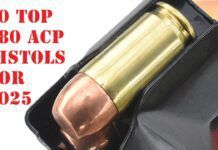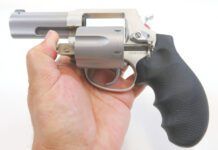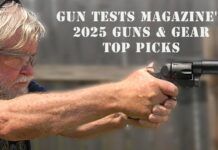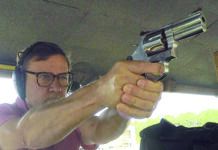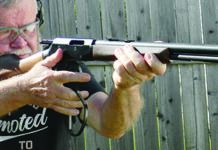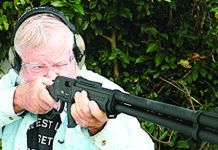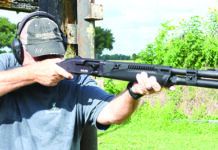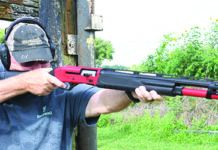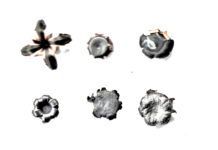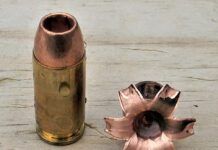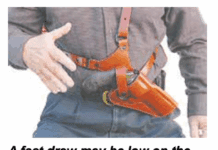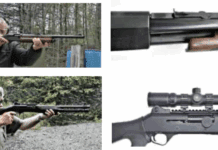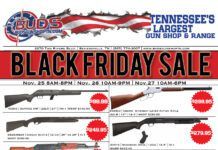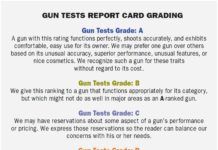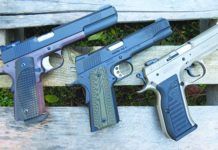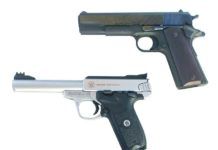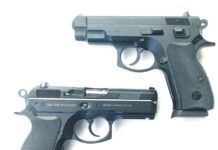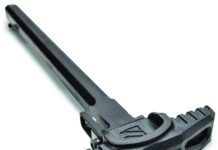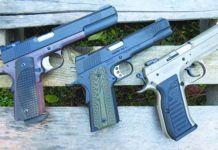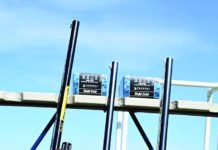Grading the Gun Grades
Your reader asks who would want to buy a gun rated at C? About 12 years ago, I bought a new CZ 83 pistol. You would have rated this particular pistol an F because of constant Failure to Fire and Failure to Eject problems. But after CZ sent it back, the gun has been 100% reliable and has become a favorite because it perfectly fits my old, extra-large, and arthritic hands, and provides excellent accuracy with modest recoil. I was pleased to see your A rating on this gun years later. I've found giving each gun a second chance to be a worthwhile practice.
Getting Brighter on Fiber Optics
In the technical module about the Dan Wesson Bruin Bronze 1881 10mm pistol, there is the statement, "The Dan Wesson front sight uses a fiber optic to charge up a tritium dot." While it is true that some "glow in the dark" items collect light energy when illuminated and then glow in the dark for a while, that has nothing to do with how tritium sights work. The tritium sights glow because tritium gas (the radioactive isotope of hydrogen) is sealed in a small, gas-tight hollow glass bead, along with a substance that glows when struck by the radioactive particles given off by the tritium. The bead is not "charged up" by light; it continues glowing as long as the radioactivity lasts, regardless of outside conditions. I'm not sure what the fiber-optic element in the sight does, but is not there to keep the tritium sight charged. The article was quite good otherwise, although I doubt any article would get me to buy a 10mm pistol.
Peruta Declined Supreme Court Hearing
I was disappointed to see that on June 26, the U.S. Supreme Court decided not to hear Peruta v. California. A Supreme Court decision would have answered some important legal questions: Does the Second Amendment's coverage for people to keep and bear arms extend outside the home? Does it cover the right to carry concealed firearms in public? Peruta might have provided definitive legal answers to those questions. Gun owners already know the answers, so we're frustrated that a natural right to self protection is hemmed in by state statutes.
Way to Go, Judicial Watch!
You may have not heard about Judicial Watch (JW), a Washington, D.C.-based watchdog group that bedevils many different agencies with requests for information that said agencies would rather not share. They use what are called Freedom of Information Act (FOIA) requests, which is part of federal law, to pry out information that should be public. Usually, federal agencies thumb their bureaucratic noses at JW and don't deliver squat, which then prompts JW to sue their sorry a***s. I admire what JW does generally, but I also like that they take on the Bureau of Alcohol, Tobacco, Firearms, and Explosives (ATF) in particular.
10mms: How About the P220?
Neat comparison of 10mms; kinda hoping you'd toss the SIG P220 in 10mm into the mix. I thought your comments on the Kimber TLE II grips were interesting. I haven't shot that model, but I own a Kimber Custom Eclipse II in 10mm and have no such issue with my grips when firing up to 100 rounds in a session. For those who would like the edges less raspy, I use blue buffing on a buffing wheel mounted in my drill press to polish out G10 revolver and knife grips. It's not too aggressive, and you could take a little edge off without substantially changing the grip's appearance. Clean up with a little denatured alcohol and a toothbrush and you're ready for the range.
A Piece of Gunmageddon Challenged
The California Rifle and Pistol Association (CRPA) and several individual plaintiffs have filed an important Second Amendment lawsuit challenging California's newly expanded Assault Weapons Control Act (AWCA). The suit, Rupp v. Becerra, seeks to have the courts declare the AWCA unconstitutional because it infringes on the right to keep and bear arms under the Second Amendment.
22-Caliber Handgun Shoot-Out: Smith, TacSol, Beretta, Colt
In this installment, we are looking at some of the best 22-caliber pistols for all-around target shooting and training for marksmanship and personal-defense practice, with an emphasis on viability for personal-defense training. Some handguns are just fine for general plinking, but the modern shooter demands the ability to train with combat lights or even a red-dot sight. All 22s do not allow this type of versatility. Let's look at four 22-caliber handguns and see how they stack up as modern trainers.
The 22 self-loading handgun is a great firearm that every handgunner should own at least one of. The 22 is a great trainer, and it is also a good small-game handgun, and it is even useful in some forms of competition. The absence of recoil and muzzle report compared to centerfire handguns is often touted, but recoil and muzzle blast are there, simply in easily manageable portions. The shooter is free to concentrate on trigger press, sight picture, sight alignment, and grip. Practice in offhand fire, combat practice, firing for extreme accuracy from a solid rest, clearing malfunctions and hunting game are just some of the practice that may be accomplished with the 22 pistol. For small-game hunting, excellent accuracy is demanded. For combat practice—and this is an important point—the handgun should be similar to the centerfire defense gun in accuracy. In that manner, the shooter isn't given a false sense of security by a 22 that is much more accurate than the 9mm or 45 they use for personal defense. When practicing with the 22, the serious shooter should use the same grip and trigger press that he or she uses when mastering the 9mm or 45. Using a lighter grip or shooting fast just because the 22 is so controllable doesn't cross over into personal defense skills; it is simply shooting for fun.
We collected two 22-caliber handguns and two 22-caliber conversion units for comparison. One of the handguns is a new model and the other, a relatively new and often overlooked pistol. The firearms tested included the Smith & Wesson Victory 22, Beretta Neos 22, Tactical Solutions' Glock conversion unit, and a Colt 22 Ace conversion unit.
9mms: Just in the Nick of Time
Great article! I really liked the comparison of three 10mm pistols with different philosophies at work: a 1911, a striker-fired Glock, and a SIG. One thing that I don't understand after reading the comments and the article is how an evaluator in a consumer magazine wouldn't consider factors like price. It seems like testers were dissatisfied with the SIG's rating. Some justification for the B grade might be the lower capacity, high bore axis, higher weight, and how the price is more than double that of other competitors with comparably performing pistols.
New Accessories, Gear, and Ammunition Choices for 2017
As prices continue to come down as the result of a gun glut (supply and demand economics), more folks will be buying guns, and we'll want to shoot them. So we will be adding enhancements to those firearms and feeding ammunition into them with a big grin. Here are some new products Gun Tests' staffers have taken note of that will make your firearms run, run better, or add fun.
Three More 10mm Autos: Kimber, Dan Wesson, Tanfoglio
Last year we tested three 10mm Auto pistols and found there was a lot of interest in these big-bore handguns, so we decided to return to these powerful handguns for another look. Our most recent crop of 10mms includes two 1911 platforms and one based on the CZ 75 platform. The Kimber Custom TLE II and the Dan Wesson Bruin Bronze share the 1911 platform, while the Tanfoglio Witness is based on the CZ 75 design. We liked all three of these pistols and found that all three could serve multiple duties from hunting to self-defense. Since the 10mm has the power of a 41 Magnum, we feel it is a bit much for everyday carry. If we ever were in a shooting incident, it's possible the overpenetration of the 10mm could be a liability. But in a self-defense situation where you are facing an angry bear in the back country, we think the 10mm Auto makes perfect sense. Also, as a hunting round, the 10mm offers a lot of power and is well suited for game like deer and pigs at short distances. We'd even use it in a tree stand to take black bears visiting a bait.
All three pistols ran exceptionally well with no malfunctions or jams, and we found they were accurate. Two-inch five-shot groups at 25 yards were the norm. For ammunition, we used SIG Sauer V-Crown Ammunition loaded with an 180-grain JHP bullet. The SIG ammo was loaded to velocities that 10mm Auto was designed for.
The other two loads were Federal American Eagle and Armscor USA labels, both using 180-grain FMJs. These two rounds weren't as hot as the SIG load, as the table data reveal. The SIG ammo factory data shows a muzzle velocity of 1250 fps; we got very close to that muzzle velocity from the Kimber and Dan Wesson. The Tanfoglio produced less velocity. The Federal and Armscor ammo is factory-speed stamped at 1030 fps and 1008 fps, respectively. With the three pistols, we saw higher muzzle velocities than the factory figures.
For accuracy testing, we used a rest and open sights, firing at targets placed 25 yards downrange. For our speed stage, we fired at 10 yards. A fast and accurate follow-up shot was faster with the Bruin and Witness, which we will get into shortly. Remember that a 10mm Auto is not a learner's pistol or for those who are sensitive to recoil. In our opinion, the Bruins and the Witness helped us manage recoil the best. Shooting this trio side by side at the range, we learned a lot about them. Here's the skinny on all three.
Brownings Sweet Sixteen: Still Sweet After All These Years?
The popularity of the 16-gauge shotgun, in particular the Browning A5 Sweet Sixteen, has never waned among those select shooters with a streak of nostalgia in their genetic makeup. A common refrain of, "I've still got my granddad's old 16 — best bird gun ever made," is often heard whenever veteran shooters gather to share tales of old or create new memories of quality time in the outdoors.
Responding to a reader's request, we decided to give the recently unveiled Browning A5 Sweet Sixteen that premiered at the 2016 SHOT Show a closer look to see what motivates the 16 gauge's small, but very loyal, fan base. The new semiautomatic is built with a smaller, lighter receiver than the old-style Humpback and utilizes a different recoil system than the long-recoil creation of legendary firearms genius John M. Browning, so only time will tell if it has the lasting power of its predecessors.
The Light Twelve was added to the mix for a couple of reasons. First, the older Sweet Sixteen is built on the same-sized frame as the 12 gauge. Also, we wanted to see if the 16 gauge lives up to its reputation as a more sporting shooting tool. And, of course, 12-gauge ammunition is much more available than 16-gauge shotshells, and if the potential wingshooter is in the market for one of these Humpbacks, how much will nostalgia and pride of ownership of a "Sweet Sixteen" override the economics of shooting the bigger gauge, assuming similar performance?
More Winning Gun Laws, Please
Man, everywhere you look, there's good new laws pertaining to guns, gun rights, gun culture, you name it. At the top of the list would be sending congratulations to our subscribers in North Dakota. Governor Doug Burgum (R) signed House Bill 1169 into law. HB 1169 will eliminate the requirement to obtain a permit in order to lawfully carry. HB 1169 will make the current permitting system optional to allow citizens to obtain permits and take advantage of reciprocity agreements with other states.


